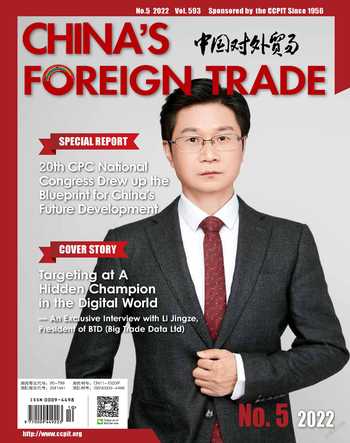RCEP Brings Opportunities for Cross-Border E-commerce
By Liu Xinwei

Recently, the 2022 World Cross-border E-commerce Conference (hereinafter referred to as the Conference) was held in Nansha District, Guangzhou City) with the theme of“Cross-border Digitalization, RCEP Development”.
In his speech at the conference, Zhang Dawei, Vice Chairman and Secretary-general of the China Center for International Economic Exchanges, said that cross-border e-commerce is a product driven by economic globalization and modern information technology. In the form of electronic data, it uses various platforms to carry out information matching and trading activities, promoting the reengineering of the whole process from production to consumption and changing the traditional industrial chain and supply chain. At present, the Chinese governments continuous institutional and regulatory innovations have effectively promoted the development of new forms of cross-border e-commerce and the reconstruction of supply chains.
Chinas cross-border e-commerce has followed a pattern of internal and external linkage and east-west mutual benefits
The 2021 Development Report on Cross-border E-commerce in Chinese Cities (hereinafter referred to as the Report), which was released at the same time as the Conference started, shows that different cities have different levels of cross-border e-commerce development. In 2021, there were 24 cities in China with a GDP exceeding RMB 1 trillion. The top 10 cities were Shanghai, Beijing, Shenzhen, Guangzhou, Chongqing, Suzhou, Chengdu, Hangzhou, Wuhan and Nanjing. The Pearl River Delta, Yangtze River Delta and Bohai Rim have rich manufacturing formats and operate on a large scale, providing a rich product foundation for crossborder e-commerce import and export.
In terms of business environment, Beijing, Shanghai, Guangzhou and Shenzhen ranked among the top four. As for cross-border e-commerce policies, cities with sound system construction included Beijing, Shanghai, Tianjin, Guangzhou, Shenzhen, Suzhou, Nanjing, Hangzhou and Chengdu. Among these, Guangzhou issued a total of 119 policies to facilitate cross-border e-commerce and 206 policies to promote the development of crossborder e-commerce within the region.
In terms of industry scale, in 2021, cross-border e-commerce exports were mainly from Guangdong, Zhejiang, Fujian and Jiangsu, accounting for a total of nearly 80%; the consumption of imported goods was concentrated in Guangdong, Jiangsu, Zhejiang, Shanghai and Beijing, accounting for a total of 50%. The agglomeration of enterprises is also closely related to the industrial chain, and the cities with strong agglomeration include Shanghai, Beijing, Guangzhou, Shenzhen and Hangzhou.
Different cities have different logistics conditions. Shanghai, Guangzhou and Shenzhen have crossborder e-commerce logistics facilities with “sea, land and air”; Shanghai, Guangzhou, Shenzhen, Beijing and Hangzhou possess strong air cargo transport capacities; port cities such as Ningbo, Tangshan, Shanghai, Guangzhou and Qingdao have mature port logistics; and border cities such as Alashankou, Suifenhe and Manzhouli have witnessed the rapid development of China-Europe freight trains.
The Report summarizes the overall development of cross-border e-commerce in Chinese cities. At present, Chinas cross-border e-commerce has followed a pattern of internal and external linkage and eastwest mutual benefits. The BeijingTianjin-Hebei Region, the Yangtze River Delta and the Greater Bay Area have obvious advantages, while provincial capitals and economically developed cities are developing rapidly, and border cities and logistics hub cities have huge potential. At the same time, problems such as uneven development basis, fierce competition, incomplete industrial chains, weak industrial agglomeration capacities and widespread lack of talent still exist. The Report suggested that policies and measures should be targeted at strengthening interconnected development among regions, accelerat-ing the training of professionals and encouraging innovation through a variety of models.
RCEP brings new opportunities for cross-border e-commerce
“Cross-border e-commerce is the fastest growing sector with the largest contribution among all fields in China, but it is also facing many challenges,”State Council Counselor Tang Min pointed out.
In Q1 of this year, Chinas crossborder e-commerce grew at a slower pace than foreign trade for the first time. One important reason for this is that the demand is falling and the risk of a world recession is growing. At the same time, cross-border e-commerce is moving from a marketplace model to social e-commerce and Internet celebrity e-commerce, and from “staple goods” to diversified and personalized products. There will only be new opportunities when the cross-border e-commerce industry adapts to new changes.
Amid all these risks, the RCEP brings a glimmer of hope. The RCEP constitutes Chinas largest overseas market, and its members are all important economic and trade partners of China. Meanwhile, China is also the largest trading partner of the majority of RCEP members.
Since the RCEP has taken effect, China is further opening up to the outside world and the flow of goods is becoming still more free. More than 90% of trade among RCEP members will be tariff-free, covering approximately USD 1.6 trillion of Chinas annual import and export trade with other RCEP members, which exceeds 30% of Chinas total foreign trade.
Yi Xiaozhun, former Deputy Director-general of the WTO and former vice minister of the Ministry of Commerce, said that the RCEP is a comprehensive, modern, high-quality and mutually beneficial free trade agreement. It not only covers market access rights, such as trade in goods and services, but also covers investment, economic and technological cooperation, intellectual property rights and e-commerce. It will encourage further integration, consolidation and development of industrial, supply and value chains within the region.
“Guangzhou is the first city in China to introduce a specialized policy for RCEP cross-border e-commerce. Cross-border goods being sent between member countries can be released within 24 hours. This regulation makes the flow of goods between member countries more efficient and smooth, reduces transportation costs, and provides consumers with a better cross-border shopping experience,”elaborated Yi Xiaozhun.
In order to promote the further development of cross-border e-commerce, Yi Xiaozhun suggested: “we should take full advantage of the Pearl River Delta import and export trade advantages, promote cross-border e-commerce system innovation and continue to support overseas warehouse construction. We may also consider taking the fresh cold chain as the entry point, strengthen and deepen crossborder e-commerce cooperation with ASEAN countries, and implement the trade facilitation provisions of the RCEP with high quality. At the same time, an overseas dispute and risk prevention agency will be set up to promote relevant dispute prevention and resolution mechanisms in the cross-border e-commerce sector. In addition, by relying on the dual advantages of Guangzhou as ‘the capital of live streaming e-commerce and ‘the city of crossborder e-commerce, we should also strengthen the cultivation of crossborder foreign language live streaming talent, and integrate resources such as foreign affairs, universities, enterprises and the media to make new breakthroughs with talent.”
Nansha Plan acts as bridge between domestic and international
In recent years, with the launch of Measures to Promote Leapfrog Development of E-commerce, Measures of Guangzhou to Accelerate Quality Development of Cross-border E-commerce, and Measures of Guangzhou to Seize the RCEP Opportunity to Promote Innovative Development of Cross-border E-commerce, Guangzhou is seizing the RCEP opportunities to accelerate innovative development of cross-border e-commerce and build a sound ecosystem for the development of cross-border e-commerce.
In June this year, the State Council issued the Overall Plan for Guangzhou Nansha Deepening Comprehensive Cooperation Among Guangdong, Hong Kong and Macao Facing the World, also known as the Nansha Plan. Taking 2025 and 2035 as key points on the timeline, the Plan sets out the main goals in terms of scientific and technological innovation systems and mechanisms, the public service level and the business environment, aiming to deepen the connection between Nansha and Hong Kong and Macaos rules and mechanisms in such key areas as joint scientific and technological innovation, industrial integration and development, in-depth cultural exchanges, and smart city development and construction. It is imperative to actively attract professionals from Hong Kong and Macao to participate in the construction and management of Nansha.
“Hong Kong and Macao have always been our main partners for foreign investment and foreign trade, and Hong Kong is also an important channel through which foreign capital can enter China and for domestic capital to go overseas. Through the introduction of policies, we will bring more new market opportunities and enable more enterprises to make good use of the platform provided by Hong Kong,” said Xie Xiaohui, Vice Chairman of Nansha District CPPCC and director of the Bureau of Commerce.
The advantages of buying and selling across the world and connecting domestic and foreign countries make Nanshas superiority prominent for developing cross-border trade. At present, a total of about 600 enterprises have registered in Nansha to carry out cross-border e-commerce. On this basis, Nansha has taken the lead in building a global traceability center, making crossborder commodities logistics, enterprise and quality information available using just one code. These commodities cover all categories, such as food, consumer goods and automobiles, with a total of 108 million codes.
“Currently, Nansha is speeding up the establishment of internationally compatible rules and systems for investment, financing, trade and arbitration, so as to provide a worldclass business environment for Hong Kong and Macao industries to invest and start businesses in Nansha,”revealed Li Haizhou, Office Director of the Guangzhou Greater Bay Area.
- China’s foreign Trade的其它文章
- The Development of Foreign Trade in China over Last Decade:Higher-level Opening-up to the Outside World
- New Changes in Travel:Past Visitors Are Become Today’s Experiencers
- China’s Livestreaming Enters A New Phase of Development
- The Pension Industry Calls for New Models and Ecology
- Digital Technology Promotes China-foreign Trade in Agricultural Services
- As Shipping Costs“Dive”,It Is Imperative to Improve the Layout of Industrial Chain

